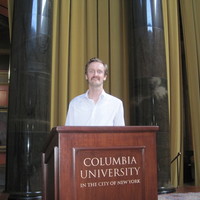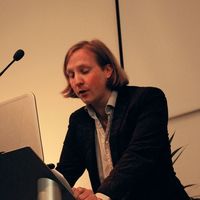Papers by Stefan Gelfgren
Is there such a thing as digital religion? : Review of "Digital Religion: Understanding Reli... more Is there such a thing as digital religion? : Review of "Digital Religion: Understanding Religious Practice in New Media Worlds"

Temenos - Nordic Journal for the Study of Religion, 2023
This article deals with the paradoxical relationship between the nineteenth-century Evangelical R... more This article deals with the paradoxical relationship between the nineteenth-century Evangelical Revival and secularization. It is argued here that the revival and its worldview played a role in increasing pluralism and choice in the nineteenth century-a process often related to secularization. The Evangelical movement both attempted to oppose modernity and rationalism and emphasized religious freedom, voluntarism, and individualism. It therefore induced and popularized self-reflection, doubt, and deconversion. It also favoured religious democracy in opposition to a state-imposed religious monopoly (at least in northern Europe). Furthermore, by dividing people into believers and nonbelievers, it emphasized religious polarization. This contributed to an undermining of established religious structures, fragmenting and pluralizing the religious landscape and giving people the option to abstain completely from religious commitment. The Swedish confessional (inner mission) revivalist denomination Evangeliska Fosterlands-Stiftelsen (EFS-approx. the Swedish Evangelical Mission Society), founded in 1856, is used as a case. The popular literature they published and distributed manifested an evangelical worldview. In this article four themes, based on the popular literature, are used to study empirically the changing role of religion in relation to nineteenth-century revivalism: 'the dualistic worldview'; 'conversion'; 'activism'; and 'self-reflection'.

Everyday life in the culture of surveillance, 2023
The possibilities to surveil people have increased and been further refined with the implementati... more The possibilities to surveil people have increased and been further refined with the implementation of digital communication over the last couple of decades, and with the ongoing process of digital transformation, surveillance can now go in any direction, leaving a label such as “surveillance state” somewhat outdated. Corporations and governmental organisations may surveil people, people may surveil each other, and surveillance may take place in subtle ways that are difficult for the surveilled to detect. In David Lyon’s terms, we are living in a “culture of surveillance”, a culture that surrounds and affects our everyday life. Today, it is of utmost relevance to study people’s attitudes, motives, and behaviours in relation to the fact that we live in a culture of surveillance. This includes the need for cultural and ethical perspectives to understand and nuanced contemporary discussions on surveillance, not least in the highly digitalised context of the Nordic countries. The chapters in this anthology address these issues from a variety of disciplinary and theoretical frameworks.

Lychnos: Årsbok för idé- och lärdomshistoria
In this article we discuss the benefits of applying a mixed methods approach to the history of id... more In this article we discuss the benefits of applying a mixed methods approach to the history of ideas. The article is based upon two cases of different character, applying methods from the field of digital textual analysis, and from the field of digital spatio-temporal map visualization. One case concerns all churches and prayer chapels in the Diocese of Luleå, and comprises 1200 entry points. The project originates in the question of whether a Bible belt exists in the north of Sweden; what it (if there is one) looks like, what its characteristics are, and how it has evolved over time. The spatio-temporal visualization both clarifies general patterns of religious fervor, but also reveals “white spots” and areas of conflicting interests, creating questions for further research. The second case stems from a larger project investigating contemporary online use of the concept “Creativity”. Here, distributional concept analysis is performed using Sketch Engine on the corpus English Web 2...
Number and name Project Number: 032518 QVIZ, Query and context based visualization of time-spatia... more Number and name Project Number: 032518 QVIZ, Query and context based visualization of time-spatial cultural dynamics Work Package WP8 Task 8.1
CONTOC- Churches in times of Coron
Masaryk University Journal of Law and Technology, 2012

Journal of Religion, Media and Digital Culture, 2016
This article studies how the Laestadian movement (a Christian confessional revivalist movement th... more This article studies how the Laestadian movement (a Christian confessional revivalist movement that is sceptical of technology) uses digital media in general, and the internet in particular, in its work. In a time when churches on a large scale are concerned with how to communicate with people through digital media, the Laestadian movement choses another path, based upon other assumptions and choices. The focus here is on how congregations and representatives use digital media, and not on individual and private use, and this article will focus primarily on Sweden and Finland. Based on interviews with representatives and by mapping the congregations’ online presence, this article provides an interpretation of the use of the internet within Laestadianism. Through this group, we see how ideology, faith, and practices regulate a restricted, negotiated, and conscious use of the internet, which challenges any preconceptions regarding use and effect of the internet on religion. This case s...
"Let there be digital networks and God will provide growth?" : Comparing aims and hopes... more "Let there be digital networks and God will provide growth?" : Comparing aims and hopes of 19th century and post millennial Christianity
Arsbok For Kristen Humanism, 2013
Online Heidelberg Journal For Religions on the Internet, 2014

Nordicom Review, 2015
In summer 2012, the Archbishop of the Church of Sweden appeared on Twitter. There was only one pr... more In summer 2012, the Archbishop of the Church of Sweden appeared on Twitter. There was only one problem - it was not the Archbishop himself who was tweeting, but an anonymous person. A discussion then ensued on Twitter and in the blogosphere between those in favor of the Archbishop and his department and mainly social media proponents.The present article describes and analyzes the social media debate, and how authority and hierarchies are negotiated in and through social media. The analysis is based on Heidi Campbell’s “Religious-Social Shaping of Technology” model, and emphasizes the need to take into account not only the faith and tradition of the religious actor, but also the societal context in which the negotiating process takes place. In this case, the concepts of “mediatization” and “secularization” are used to understand the broader context of the process.
Nordicom Review, 2020
Users of digital media leave traces that corporations and authorities can harvest, systematise, a... more Users of digital media leave traces that corporations and authorities can harvest, systematise, and analyse; on the societal level, an overall result is the emergence of a surveillance culture. In this study, we examine how people handle the dilemma of leaving digital footprints: what they say they do to protect their privacy and what could legitimise the collection and storing of their data. Through a survey of almost 1,000 students at Umeå University in Sweden, we find that most respondents know that their data are used and choose to adjust their own behaviour rather than adopting technical solutions. In order to understand contemporary forms of surveillance, we call for a humanistic approach – an approach where hermeneutic and qualitative methods are central.
”Det kristna fornuftets banerforare” : Recension av Sallskapet: Tro och vetande i 1900-talets Sve... more ”Det kristna fornuftets banerforare” : Recension av Sallskapet: Tro och vetande i 1900-talets Sverige











Uploads
Papers by Stefan Gelfgren
To understand this situation and nuance the contemporary discussions about surveillance – not least in the highly digitalised context of the Nordic countries – we must adopt cultural and ethical perspectives in studying people’s attitudes, motives, and behaviours. The “culture of surveillance”, to borrow David Lyon’s term, is a culture where questions about privacy and publicness, and rights and benefits, are once again brought to the fore.
This anthology takes up this challenge, with contributions from a variety of disciplinary and theoretical frameworks that discuss and shed light on the complexity of contemporary surveillance and thus problematise power relations between the many actors involved in the development and performance of surveillance culture. The contributions highlight how more and more actors and practices play a part in our increasingly digitalised society.
The book is an outcome of the research project “iAccept: Soft surveillance – between acceptance and resistance”, financed by the Marcus and Amalia Wallenberg Foundation. The anthology’s editors are project members, all based at Umeå University, Sweden: Lars Samuelsson, associate professor of philosophy; Coppélie Cocq, professor of Sámi studies and digital humanities; Stefan Gelfgren, associate professor of sociology of religion; and Jesper Enbom, associate professor of media studies.
To understand this situation and nuance the contemporary discussions about surveillance – not least in the highly digitalised context of the Nordic countries – we must adopt cultural and ethical perspectives in studying people’s attitudes, motives, and behaviours. The “culture of surveillance”, to borrow David Lyon’s term, is a culture where questions about privacy and publicness, and rights and benefits, are once again brought to the fore.
This anthology takes up this challenge, with contributions from a variety of disciplinary and theoretical frameworks that discuss and shed light on the complexity of contemporary surveillance and thus problematise power relations between the many actors involved in the development and performance of surveillance culture. The contributions highlight how more and more actors and practices play a part in our increasingly digitalised society.
The book is an outcome of the research project “iAccept: Soft surveillance – between acceptance and resistance”, financed by the Marcus and Amalia Wallenberg Foundation. The anthology’s editors are project members, all based at Umeå University, Sweden: Lars Samuelsson, associate professor of philosophy; Coppélie Cocq, professor of Sámi studies and digital humanities; Stefan Gelfgren, associate professor of sociology of religion; and Jesper Enbom, associate professor of media studies.